ABC Learning's Collapse: Accounting, ASA 701, and Government Response
VerifiedAdded on 2019/11/29
|16
|3209
|344
Report
AI Summary
This report provides a comprehensive analysis of the ABC Learning collapse, a major corporate failure in Australia's childcare industry. The study examines the company's history, rapid expansion, and subsequent financial difficulties, highlighting significant accounting issues such as the overvaluation of intangible assets and declining profitability. It explores the government's response, including inquiries and policy changes, and discusses the role of ASA 701, the auditing standard, in addressing financial irregularities and ensuring auditor accountability. The report delves into the operational date and application of ASA 701. It also covers the lessons learned from the collapse, offering insights into corporate governance, financial reporting, and the importance of independent auditing. The report also includes a detailed financial analysis, providing data on assets, debts, shareholder funds, and profitability trends, alongside a discussion of revenue and profit fluctuations, and the company's eventual delisting from the Australian Stock Exchange. The study concludes by emphasizing the significance of robust financial practices and regulatory oversight in preventing similar corporate failures.
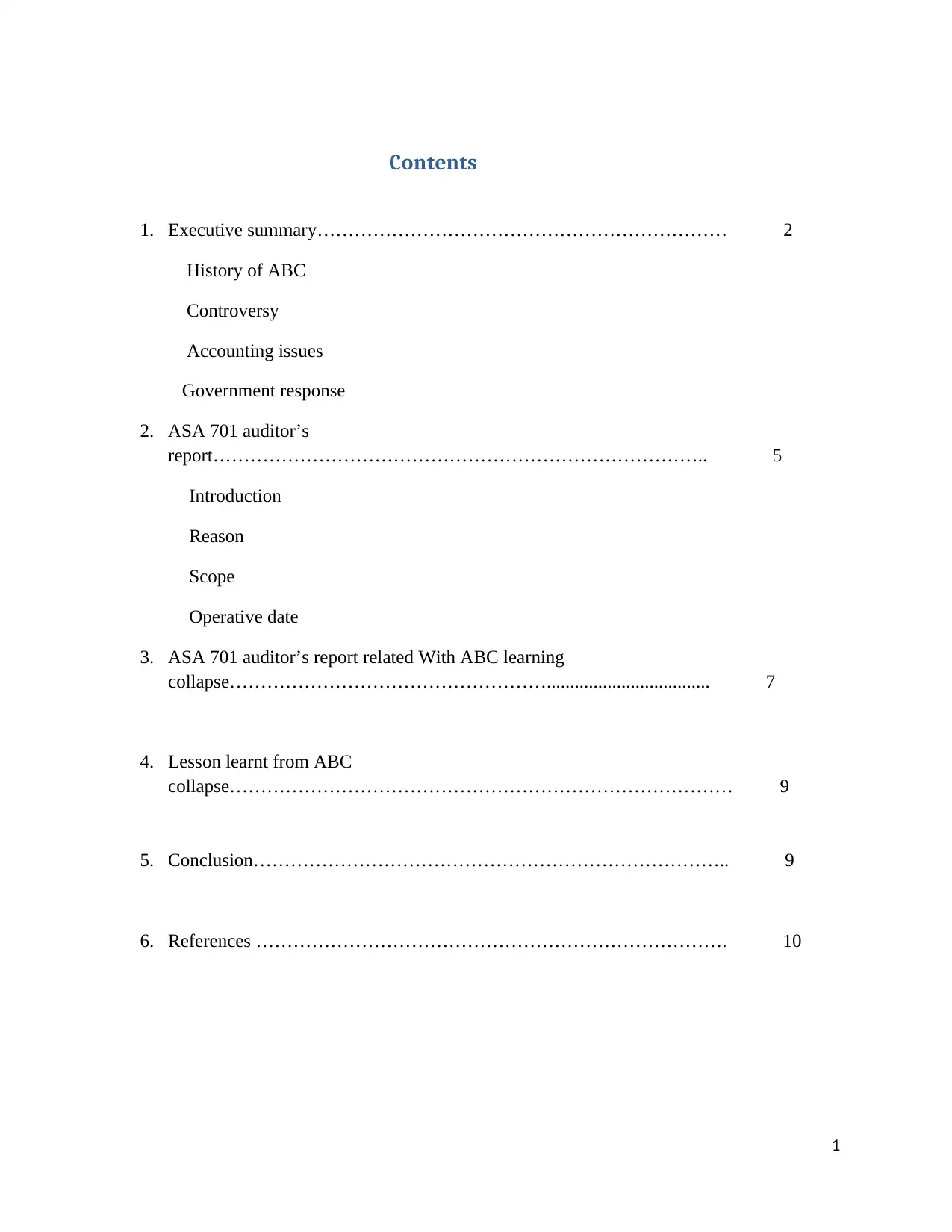
Contents
1. Executive summary………………………………………………………… 2
History of ABC
Controversy
Accounting issues
Government response
2. ASA 701 auditor’s
report…………………………………………………………………….. 5
Introduction
Reason
Scope
Operative date
3. ASA 701 auditor’s report related With ABC learning
collapse……………………………………………................................... 7
4. Lesson learnt from ABC
collapse……………………………………………………………………… 9
5. Conclusion………………………………………………………………….. 9
6. References …………………………………………………………………. 10
1
1. Executive summary………………………………………………………… 2
History of ABC
Controversy
Accounting issues
Government response
2. ASA 701 auditor’s
report…………………………………………………………………….. 5
Introduction
Reason
Scope
Operative date
3. ASA 701 auditor’s report related With ABC learning
collapse……………………………………………................................... 7
4. Lesson learnt from ABC
collapse……………………………………………………………………… 9
5. Conclusion………………………………………………………………….. 9
6. References …………………………………………………………………. 10
1
Paraphrase This Document
Need a fresh take? Get an instant paraphrase of this document with our AI Paraphraser
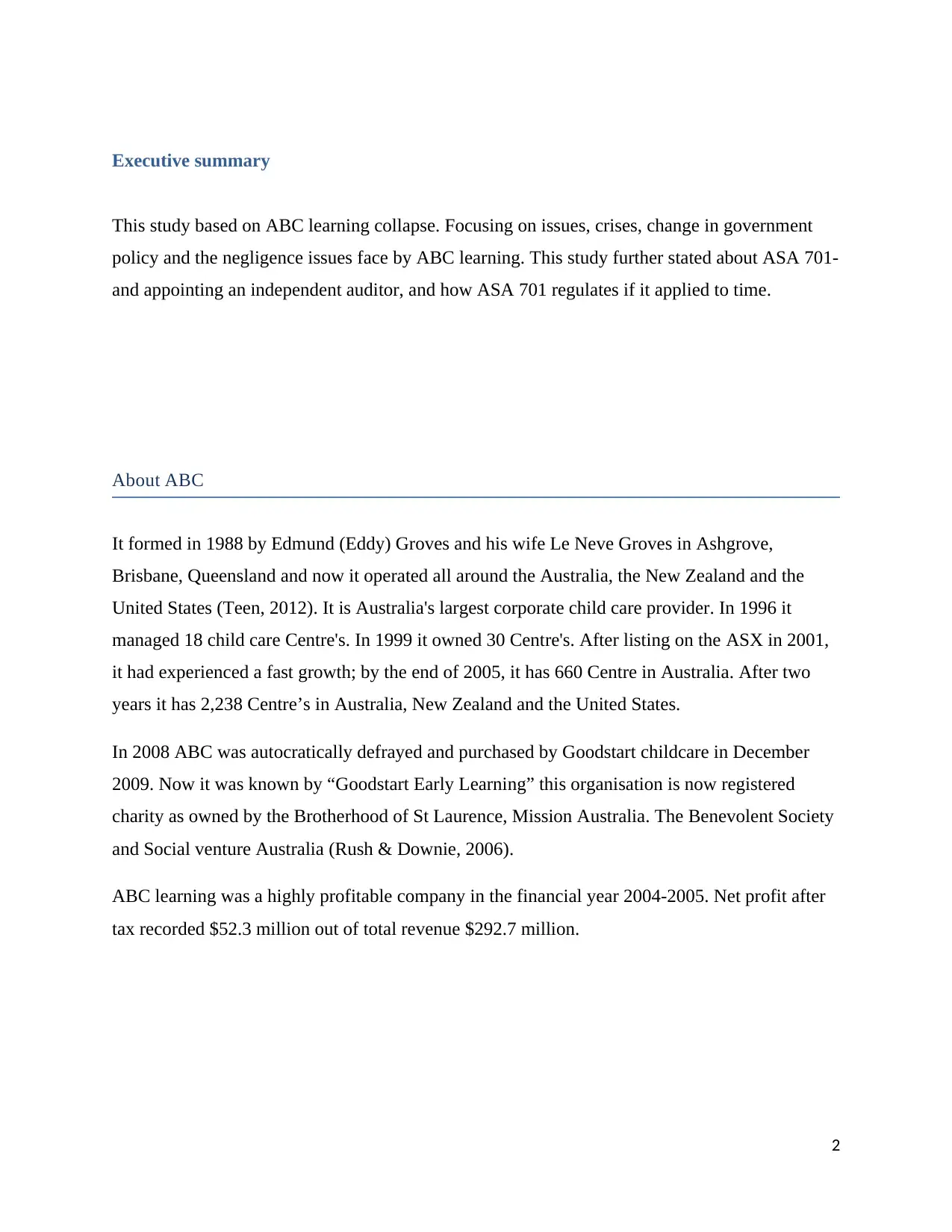
Executive summary
This study based on ABC learning collapse. Focusing on issues, crises, change in government
policy and the negligence issues face by ABC learning. This study further stated about ASA 701-
and appointing an independent auditor, and how ASA 701 regulates if it applied to time.
About ABC
It formed in 1988 by Edmund (Eddy) Groves and his wife Le Neve Groves in Ashgrove,
Brisbane, Queensland and now it operated all around the Australia, the New Zealand and the
United States (Teen, 2012). It is Australia's largest corporate child care provider. In 1996 it
managed 18 child care Centre's. In 1999 it owned 30 Centre's. After listing on the ASX in 2001,
it had experienced a fast growth; by the end of 2005, it has 660 Centre in Australia. After two
years it has 2,238 Centre’s in Australia, New Zealand and the United States.
In 2008 ABC was autocratically defrayed and purchased by Goodstart childcare in December
2009. Now it was known by “Goodstart Early Learning” this organisation is now registered
charity as owned by the Brotherhood of St Laurence, Mission Australia. The Benevolent Society
and Social venture Australia (Rush & Downie, 2006).
ABC learning was a highly profitable company in the financial year 2004-2005. Net profit after
tax recorded $52.3 million out of total revenue $292.7 million.
2
This study based on ABC learning collapse. Focusing on issues, crises, change in government
policy and the negligence issues face by ABC learning. This study further stated about ASA 701-
and appointing an independent auditor, and how ASA 701 regulates if it applied to time.
About ABC
It formed in 1988 by Edmund (Eddy) Groves and his wife Le Neve Groves in Ashgrove,
Brisbane, Queensland and now it operated all around the Australia, the New Zealand and the
United States (Teen, 2012). It is Australia's largest corporate child care provider. In 1996 it
managed 18 child care Centre's. In 1999 it owned 30 Centre's. After listing on the ASX in 2001,
it had experienced a fast growth; by the end of 2005, it has 660 Centre in Australia. After two
years it has 2,238 Centre’s in Australia, New Zealand and the United States.
In 2008 ABC was autocratically defrayed and purchased by Goodstart childcare in December
2009. Now it was known by “Goodstart Early Learning” this organisation is now registered
charity as owned by the Brotherhood of St Laurence, Mission Australia. The Benevolent Society
and Social venture Australia (Rush & Downie, 2006).
ABC learning was a highly profitable company in the financial year 2004-2005. Net profit after
tax recorded $52.3 million out of total revenue $292.7 million.
2
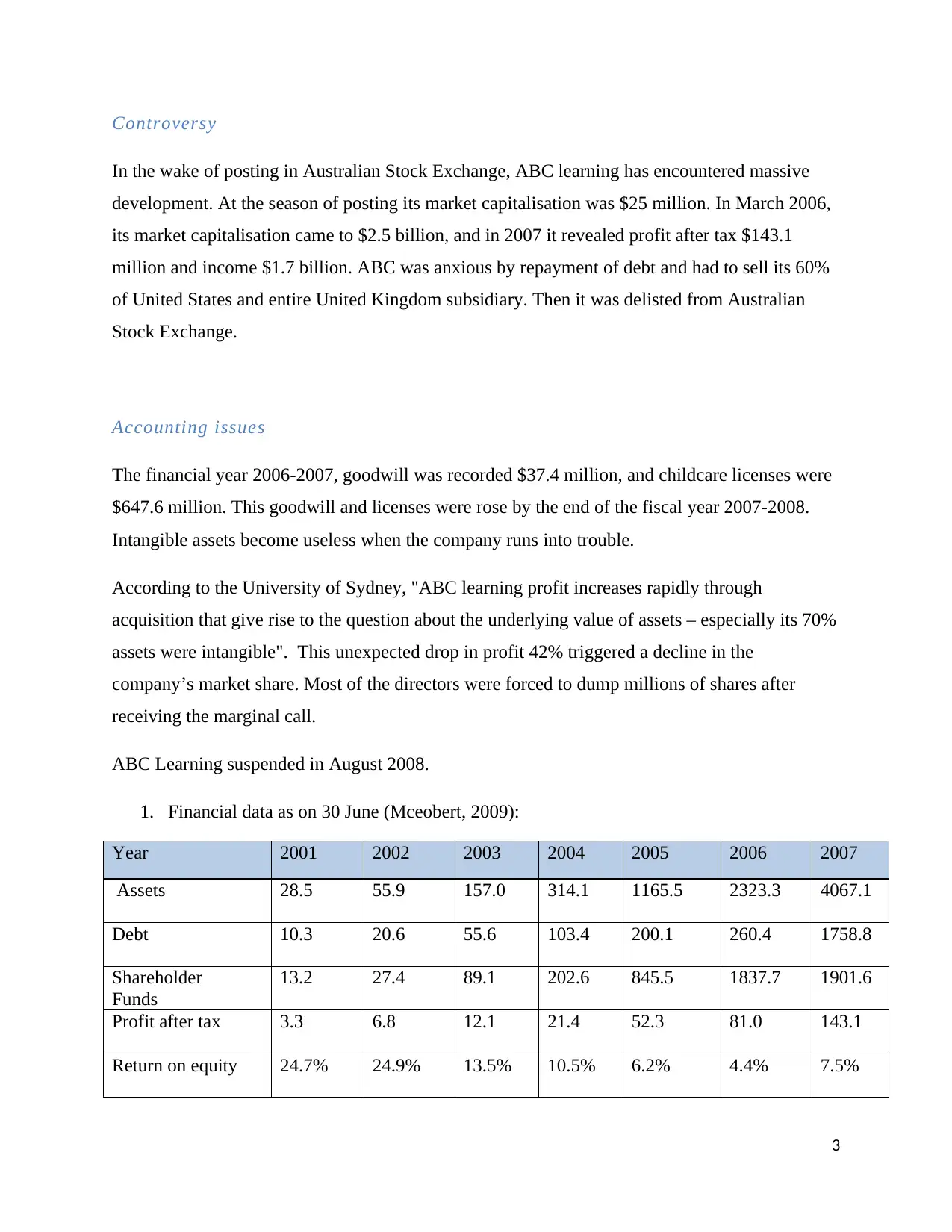
Controversy
In the wake of posting in Australian Stock Exchange, ABC learning has encountered massive
development. At the season of posting its market capitalisation was $25 million. In March 2006,
its market capitalisation came to $2.5 billion, and in 2007 it revealed profit after tax $143.1
million and income $1.7 billion. ABC was anxious by repayment of debt and had to sell its 60%
of United States and entire United Kingdom subsidiary. Then it was delisted from Australian
Stock Exchange.
Accounting issues
The financial year 2006-2007, goodwill was recorded $37.4 million, and childcare licenses were
$647.6 million. This goodwill and licenses were rose by the end of the fiscal year 2007-2008.
Intangible assets become useless when the company runs into trouble.
According to the University of Sydney, "ABC learning profit increases rapidly through
acquisition that give rise to the question about the underlying value of assets – especially its 70%
assets were intangible". This unexpected drop in profit 42% triggered a decline in the
company’s market share. Most of the directors were forced to dump millions of shares after
receiving the marginal call.
ABC Learning suspended in August 2008.
1. Financial data as on 30 June (Mceobert, 2009):
Year 2001 2002 2003 2004 2005 2006 2007
Assets 28.5 55.9 157.0 314.1 1165.5 2323.3 4067.1
Debt 10.3 20.6 55.6 103.4 200.1 260.4 1758.8
Shareholder
Funds
13.2 27.4 89.1 202.6 845.5 1837.7 1901.6
Profit after tax 3.3 6.8 12.1 21.4 52.3 81.0 143.1
Return on equity 24.7% 24.9% 13.5% 10.5% 6.2% 4.4% 7.5%
3
In the wake of posting in Australian Stock Exchange, ABC learning has encountered massive
development. At the season of posting its market capitalisation was $25 million. In March 2006,
its market capitalisation came to $2.5 billion, and in 2007 it revealed profit after tax $143.1
million and income $1.7 billion. ABC was anxious by repayment of debt and had to sell its 60%
of United States and entire United Kingdom subsidiary. Then it was delisted from Australian
Stock Exchange.
Accounting issues
The financial year 2006-2007, goodwill was recorded $37.4 million, and childcare licenses were
$647.6 million. This goodwill and licenses were rose by the end of the fiscal year 2007-2008.
Intangible assets become useless when the company runs into trouble.
According to the University of Sydney, "ABC learning profit increases rapidly through
acquisition that give rise to the question about the underlying value of assets – especially its 70%
assets were intangible". This unexpected drop in profit 42% triggered a decline in the
company’s market share. Most of the directors were forced to dump millions of shares after
receiving the marginal call.
ABC Learning suspended in August 2008.
1. Financial data as on 30 June (Mceobert, 2009):
Year 2001 2002 2003 2004 2005 2006 2007
Assets 28.5 55.9 157.0 314.1 1165.5 2323.3 4067.1
Debt 10.3 20.6 55.6 103.4 200.1 260.4 1758.8
Shareholder
Funds
13.2 27.4 89.1 202.6 845.5 1837.7 1901.6
Profit after tax 3.3 6.8 12.1 21.4 52.3 81.0 143.1
Return on equity 24.7% 24.9% 13.5% 10.5% 6.2% 4.4% 7.5%
3
⊘ This is a preview!⊘
Do you want full access?
Subscribe today to unlock all pages.

Trusted by 1+ million students worldwide
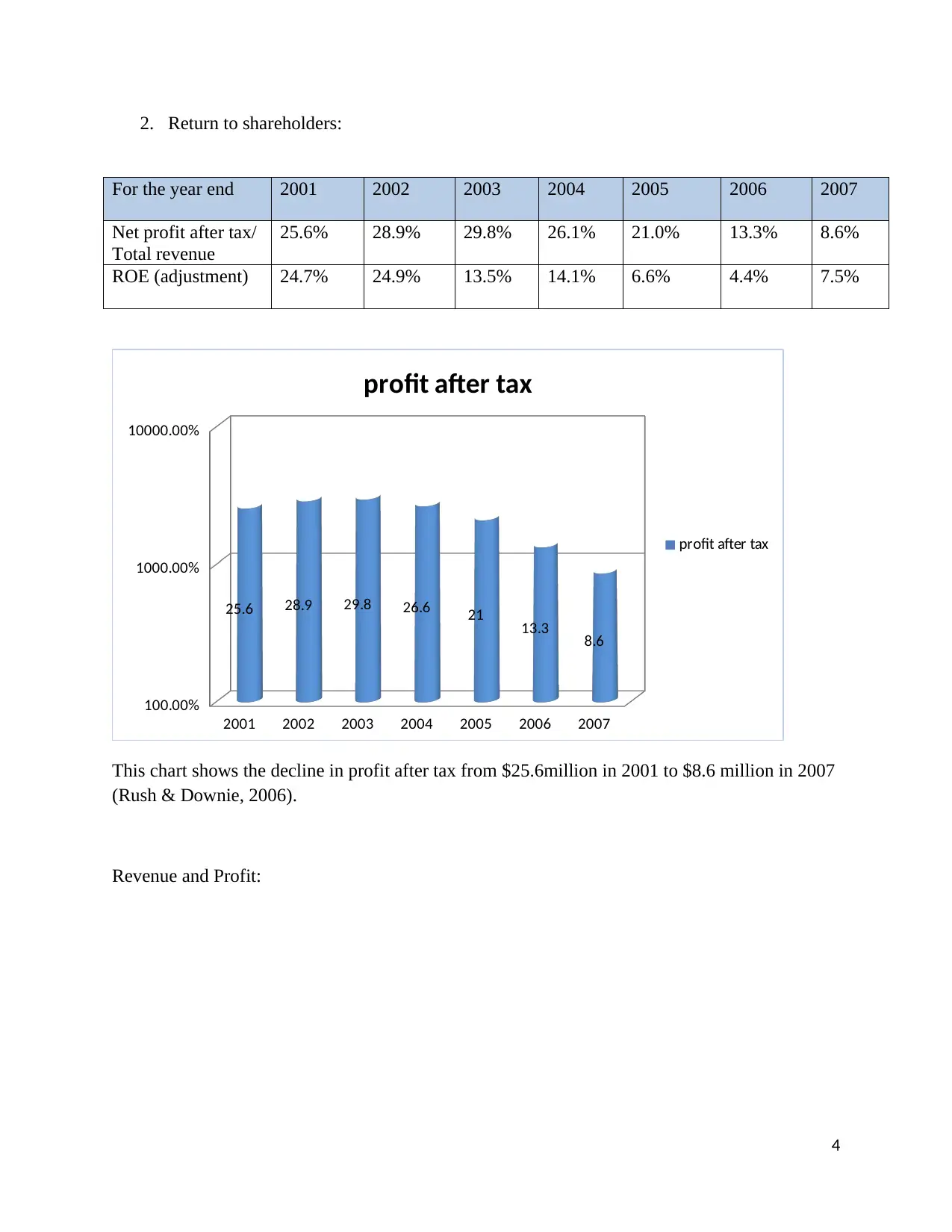
2. Return to shareholders:
For the year end 2001 2002 2003 2004 2005 2006 2007
Net profit after tax/
Total revenue
25.6% 28.9% 29.8% 26.1% 21.0% 13.3% 8.6%
ROE (adjustment) 24.7% 24.9% 13.5% 14.1% 6.6% 4.4% 7.5%
2001 2002 2003 2004 2005 2006 2007
100.00%
1000.00%
10000.00%
25.6 28.9 29.8 26.6 21 13.3 8.6
profit after tax
profit after tax
This chart shows the decline in profit after tax from $25.6million in 2001 to $8.6 million in 2007
(Rush & Downie, 2006).
Revenue and Profit:
4
For the year end 2001 2002 2003 2004 2005 2006 2007
Net profit after tax/
Total revenue
25.6% 28.9% 29.8% 26.1% 21.0% 13.3% 8.6%
ROE (adjustment) 24.7% 24.9% 13.5% 14.1% 6.6% 4.4% 7.5%
2001 2002 2003 2004 2005 2006 2007
100.00%
1000.00%
10000.00%
25.6 28.9 29.8 26.6 21 13.3 8.6
profit after tax
profit after tax
This chart shows the decline in profit after tax from $25.6million in 2001 to $8.6 million in 2007
(Rush & Downie, 2006).
Revenue and Profit:
4
Paraphrase This Document
Need a fresh take? Get an instant paraphrase of this document with our AI Paraphraser
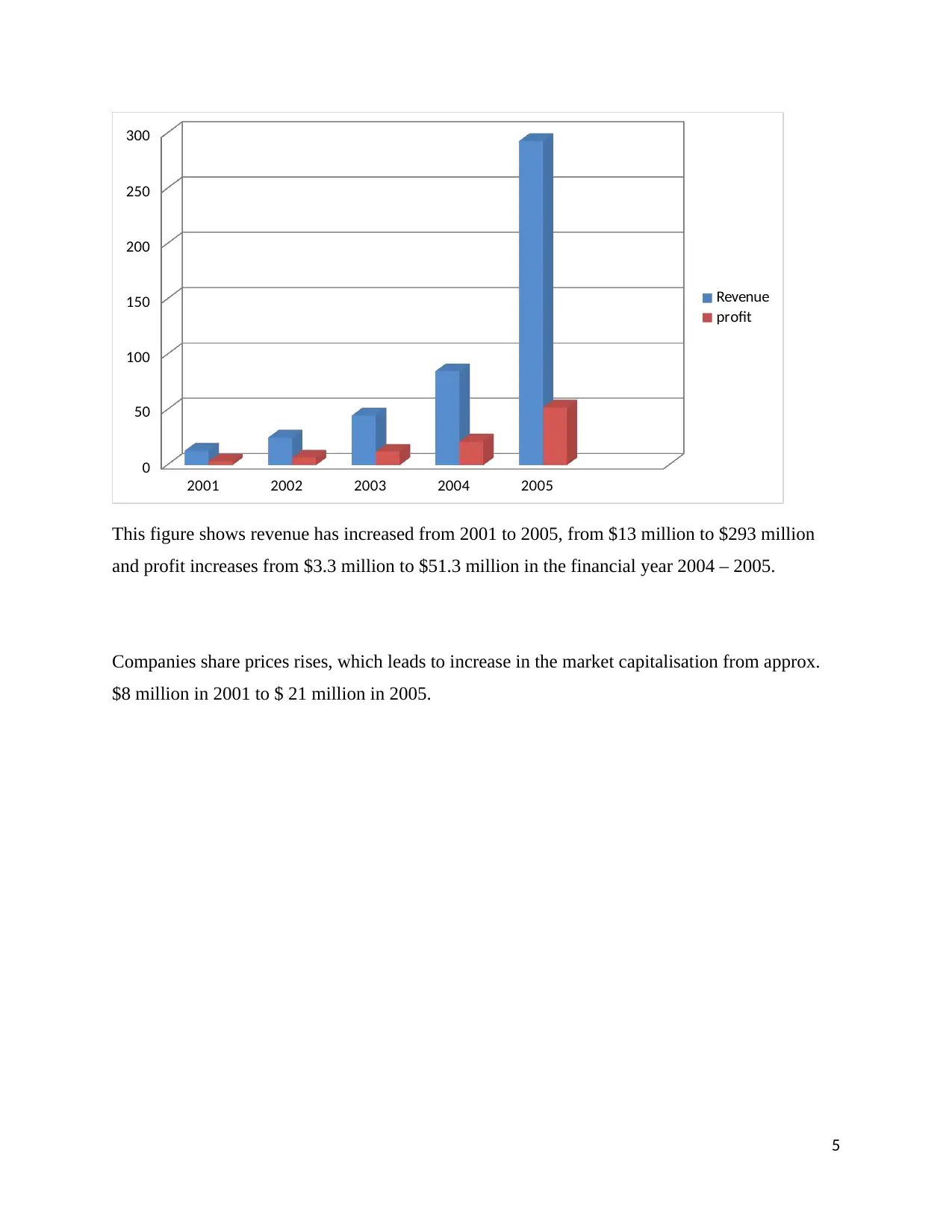
2001 2002 2003 2004 2005
0
50
100
150
200
250
300
Revenue
profit
This figure shows revenue has increased from 2001 to 2005, from $13 million to $293 million
and profit increases from $3.3 million to $51.3 million in the financial year 2004 – 2005.
Companies share prices rises, which leads to increase in the market capitalisation from approx.
$8 million in 2001 to $ 21 million in 2005.
5
0
50
100
150
200
250
300
Revenue
profit
This figure shows revenue has increased from 2001 to 2005, from $13 million to $293 million
and profit increases from $3.3 million to $51.3 million in the financial year 2004 – 2005.
Companies share prices rises, which leads to increase in the market capitalisation from approx.
$8 million in 2001 to $ 21 million in 2005.
5
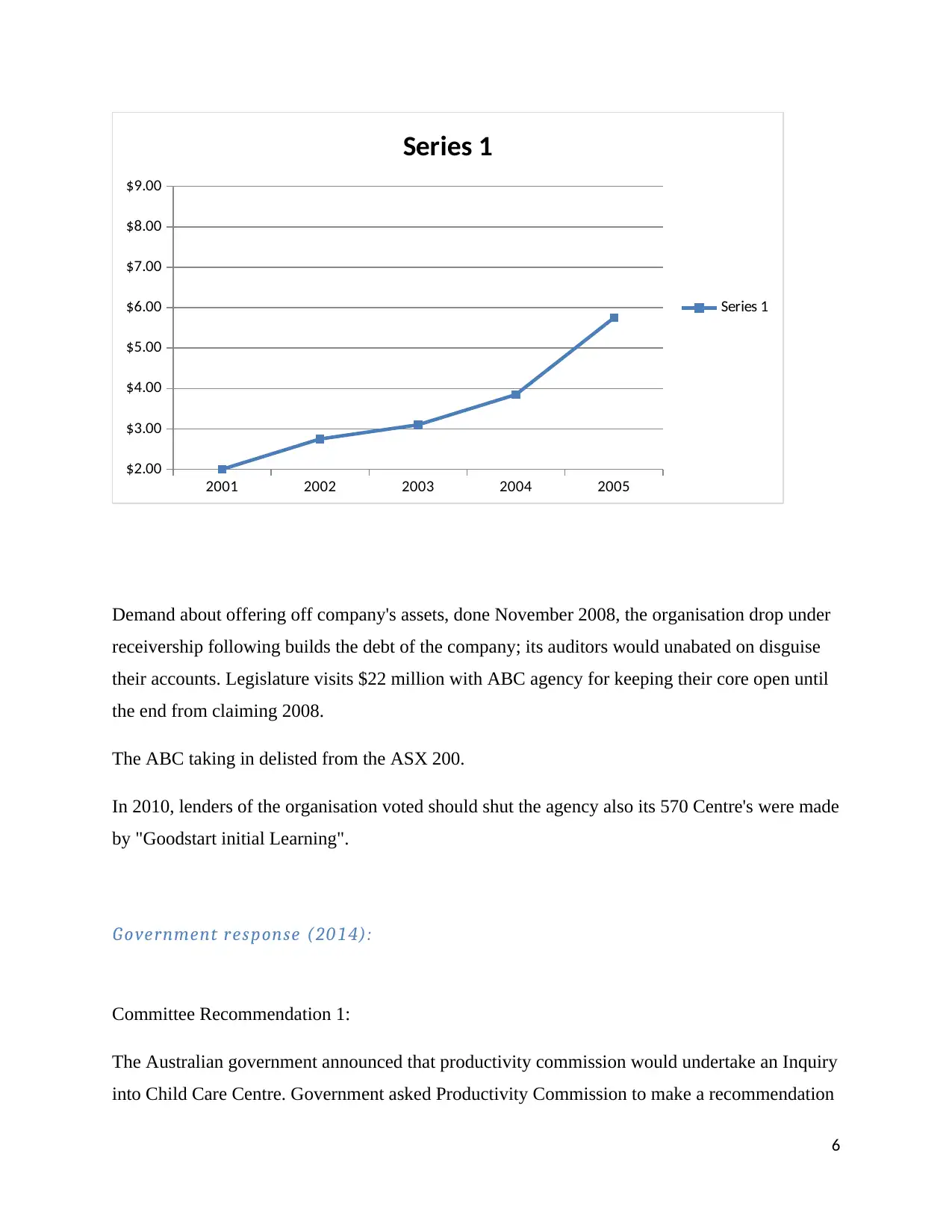
2001 2002 2003 2004 2005
$2.00
$3.00
$4.00
$5.00
$6.00
$7.00
$8.00
$9.00
Series 1
Series 1
Demand about offering off company's assets, done November 2008, the organisation drop under
receivership following builds the debt of the company; its auditors would unabated on disguise
their accounts. Legislature visits $22 million with ABC agency for keeping their core open until
the end from claiming 2008.
The ABC taking in delisted from the ASX 200.
In 2010, lenders of the organisation voted should shut the agency also its 570 Centre's were made
by "Goodstart initial Learning".
Government response (2014):
Committee Recommendation 1:
The Australian government announced that productivity commission would undertake an Inquiry
into Child Care Centre. Government asked Productivity Commission to make a recommendation
6
$2.00
$3.00
$4.00
$5.00
$6.00
$7.00
$8.00
$9.00
Series 1
Series 1
Demand about offering off company's assets, done November 2008, the organisation drop under
receivership following builds the debt of the company; its auditors would unabated on disguise
their accounts. Legislature visits $22 million with ABC agency for keeping their core open until
the end from claiming 2008.
The ABC taking in delisted from the ASX 200.
In 2010, lenders of the organisation voted should shut the agency also its 570 Centre's were made
by "Goodstart initial Learning".
Government response (2014):
Committee Recommendation 1:
The Australian government announced that productivity commission would undertake an Inquiry
into Child Care Centre. Government asked Productivity Commission to make a recommendation
6
⊘ This is a preview!⊘
Do you want full access?
Subscribe today to unlock all pages.

Trusted by 1+ million students worldwide
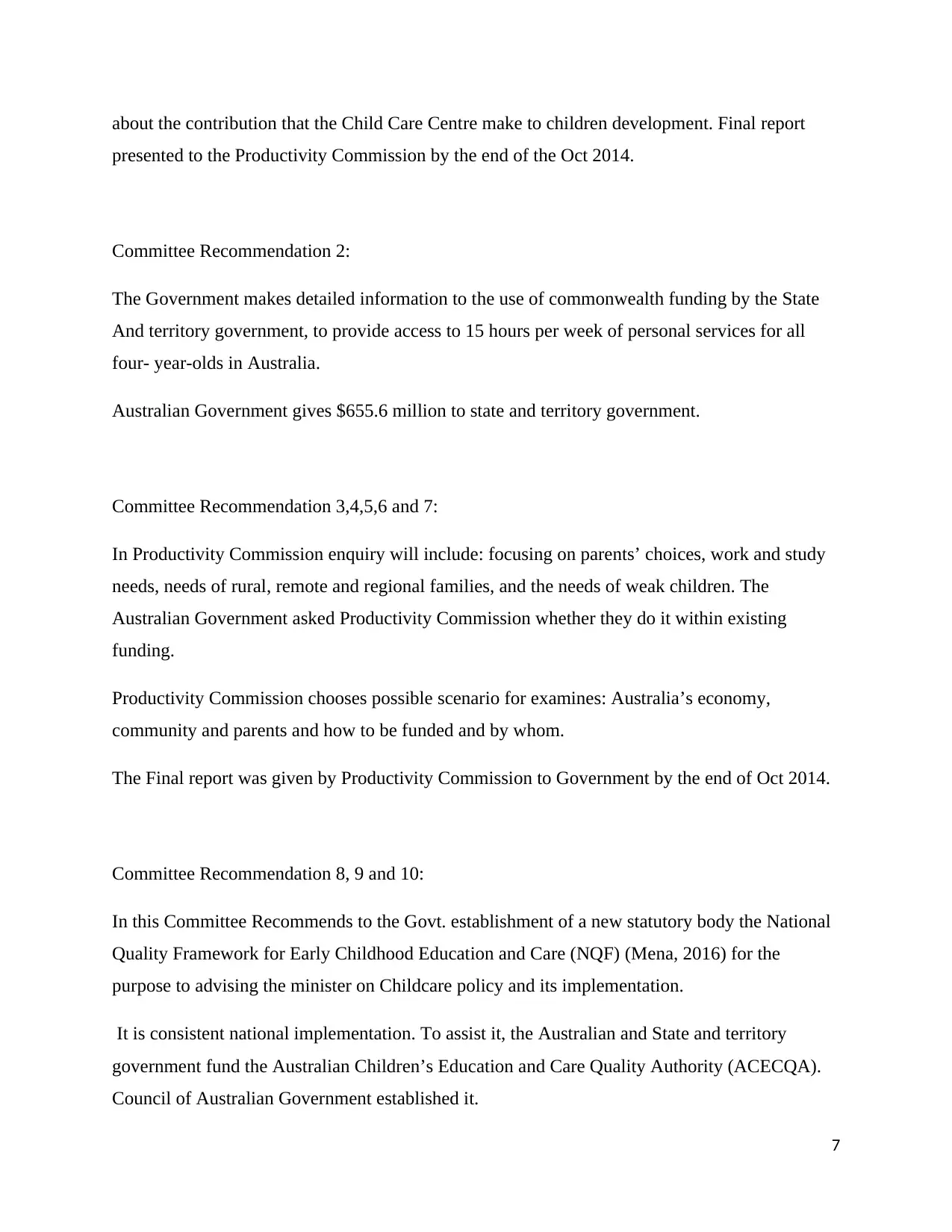
about the contribution that the Child Care Centre make to children development. Final report
presented to the Productivity Commission by the end of the Oct 2014.
Committee Recommendation 2:
The Government makes detailed information to the use of commonwealth funding by the State
And territory government, to provide access to 15 hours per week of personal services for all
four- year-olds in Australia.
Australian Government gives $655.6 million to state and territory government.
Committee Recommendation 3,4,5,6 and 7:
In Productivity Commission enquiry will include: focusing on parents’ choices, work and study
needs, needs of rural, remote and regional families, and the needs of weak children. The
Australian Government asked Productivity Commission whether they do it within existing
funding.
Productivity Commission chooses possible scenario for examines: Australia’s economy,
community and parents and how to be funded and by whom.
The Final report was given by Productivity Commission to Government by the end of Oct 2014.
Committee Recommendation 8, 9 and 10:
In this Committee Recommends to the Govt. establishment of a new statutory body the National
Quality Framework for Early Childhood Education and Care (NQF) (Mena, 2016) for the
purpose to advising the minister on Childcare policy and its implementation.
It is consistent national implementation. To assist it, the Australian and State and territory
government fund the Australian Children’s Education and Care Quality Authority (ACECQA).
Council of Australian Government established it.
7
presented to the Productivity Commission by the end of the Oct 2014.
Committee Recommendation 2:
The Government makes detailed information to the use of commonwealth funding by the State
And territory government, to provide access to 15 hours per week of personal services for all
four- year-olds in Australia.
Australian Government gives $655.6 million to state and territory government.
Committee Recommendation 3,4,5,6 and 7:
In Productivity Commission enquiry will include: focusing on parents’ choices, work and study
needs, needs of rural, remote and regional families, and the needs of weak children. The
Australian Government asked Productivity Commission whether they do it within existing
funding.
Productivity Commission chooses possible scenario for examines: Australia’s economy,
community and parents and how to be funded and by whom.
The Final report was given by Productivity Commission to Government by the end of Oct 2014.
Committee Recommendation 8, 9 and 10:
In this Committee Recommends to the Govt. establishment of a new statutory body the National
Quality Framework for Early Childhood Education and Care (NQF) (Mena, 2016) for the
purpose to advising the minister on Childcare policy and its implementation.
It is consistent national implementation. To assist it, the Australian and State and territory
government fund the Australian Children’s Education and Care Quality Authority (ACECQA).
Council of Australian Government established it.
7
Paraphrase This Document
Need a fresh take? Get an instant paraphrase of this document with our AI Paraphraser
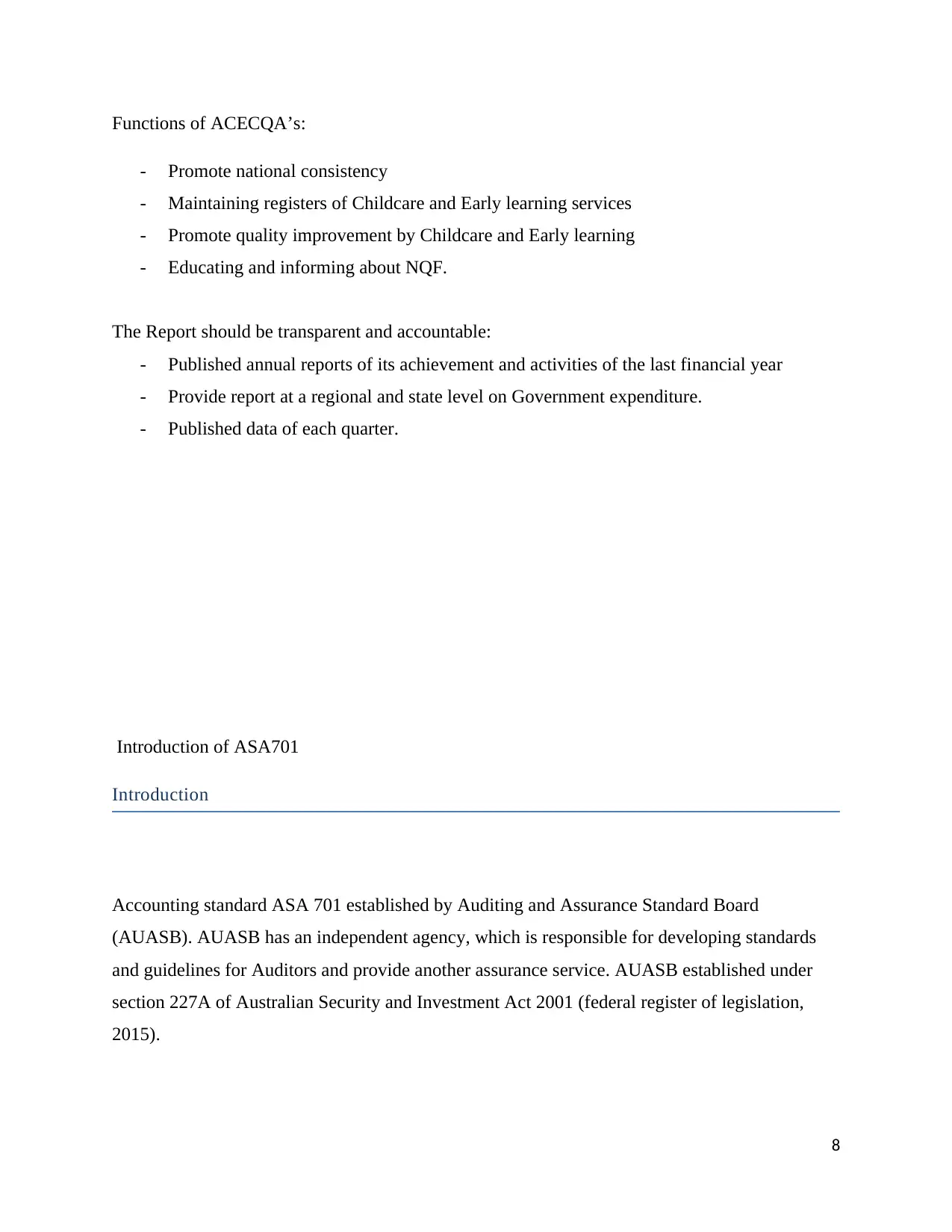
Functions of ACECQA’s:
- Promote national consistency
- Maintaining registers of Childcare and Early learning services
- Promote quality improvement by Childcare and Early learning
- Educating and informing about NQF.
The Report should be transparent and accountable:
- Published annual reports of its achievement and activities of the last financial year
- Provide report at a regional and state level on Government expenditure.
- Published data of each quarter.
Introduction of ASA701
Introduction
Accounting standard ASA 701 established by Auditing and Assurance Standard Board
(AUASB). AUASB has an independent agency, which is responsible for developing standards
and guidelines for Auditors and provide another assurance service. AUASB established under
section 227A of Australian Security and Investment Act 2001 (federal register of legislation,
2015).
8
- Promote national consistency
- Maintaining registers of Childcare and Early learning services
- Promote quality improvement by Childcare and Early learning
- Educating and informing about NQF.
The Report should be transparent and accountable:
- Published annual reports of its achievement and activities of the last financial year
- Provide report at a regional and state level on Government expenditure.
- Published data of each quarter.
Introduction of ASA701
Introduction
Accounting standard ASA 701 established by Auditing and Assurance Standard Board
(AUASB). AUASB has an independent agency, which is responsible for developing standards
and guidelines for Auditors and provide another assurance service. AUASB established under
section 227A of Australian Security and Investment Act 2001 (federal register of legislation,
2015).
8
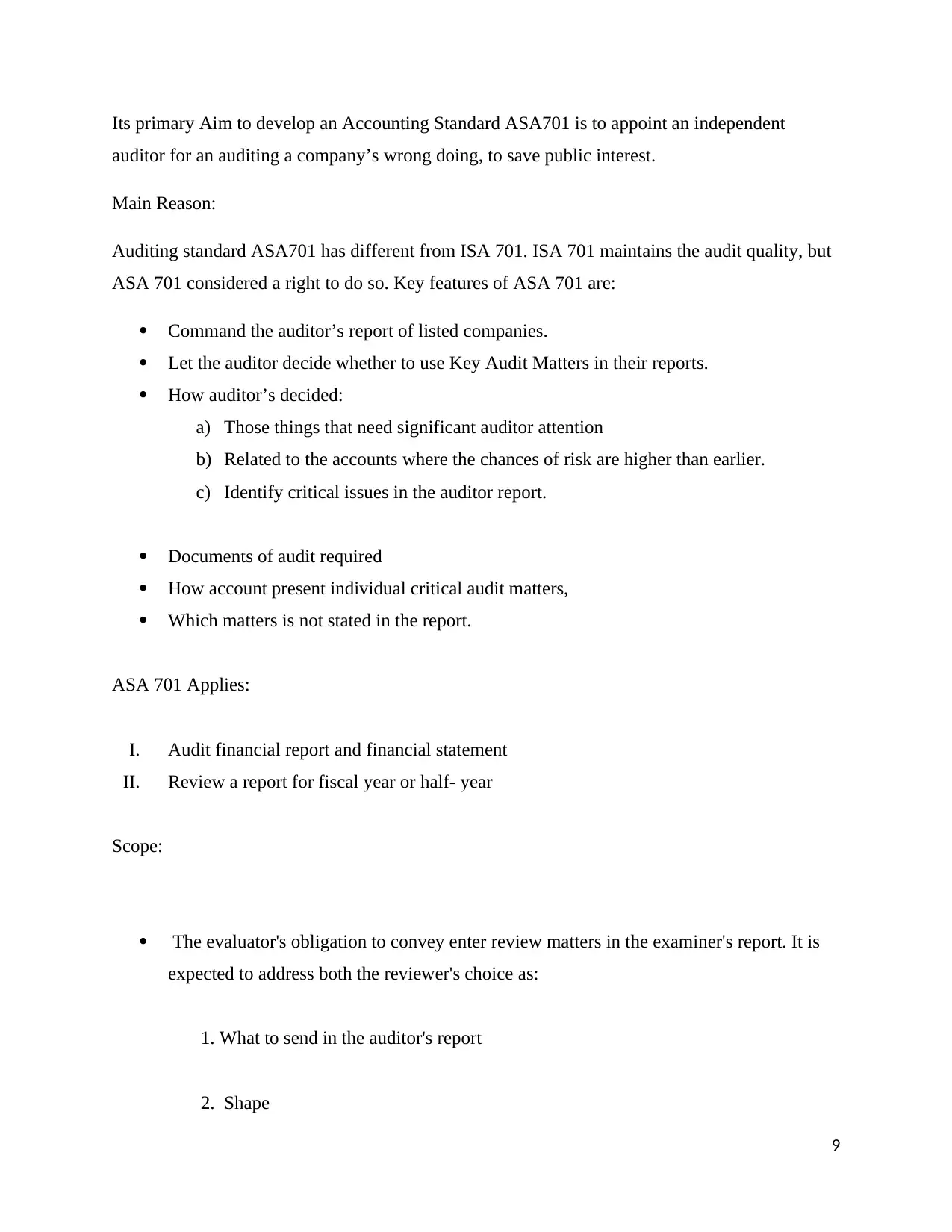
Its primary Aim to develop an Accounting Standard ASA701 is to appoint an independent
auditor for an auditing a company’s wrong doing, to save public interest.
Main Reason:
Auditing standard ASA701 has different from ISA 701. ISA 701 maintains the audit quality, but
ASA 701 considered a right to do so. Key features of ASA 701 are:
Command the auditor’s report of listed companies.
Let the auditor decide whether to use Key Audit Matters in their reports.
How auditor’s decided:
a) Those things that need significant auditor attention
b) Related to the accounts where the chances of risk are higher than earlier.
c) Identify critical issues in the auditor report.
Documents of audit required
How account present individual critical audit matters,
Which matters is not stated in the report.
ASA 701 Applies:
I. Audit financial report and financial statement
II. Review a report for fiscal year or half- year
Scope:
The evaluator's obligation to convey enter review matters in the examiner's report. It is
expected to address both the reviewer's choice as:
1. What to send in the auditor's report
2. Shape
9
auditor for an auditing a company’s wrong doing, to save public interest.
Main Reason:
Auditing standard ASA701 has different from ISA 701. ISA 701 maintains the audit quality, but
ASA 701 considered a right to do so. Key features of ASA 701 are:
Command the auditor’s report of listed companies.
Let the auditor decide whether to use Key Audit Matters in their reports.
How auditor’s decided:
a) Those things that need significant auditor attention
b) Related to the accounts where the chances of risk are higher than earlier.
c) Identify critical issues in the auditor report.
Documents of audit required
How account present individual critical audit matters,
Which matters is not stated in the report.
ASA 701 Applies:
I. Audit financial report and financial statement
II. Review a report for fiscal year or half- year
Scope:
The evaluator's obligation to convey enter review matters in the examiner's report. It is
expected to address both the reviewer's choice as:
1. What to send in the auditor's report
2. Shape
9
⊘ This is a preview!⊘
Do you want full access?
Subscribe today to unlock all pages.

Trusted by 1+ million students worldwide
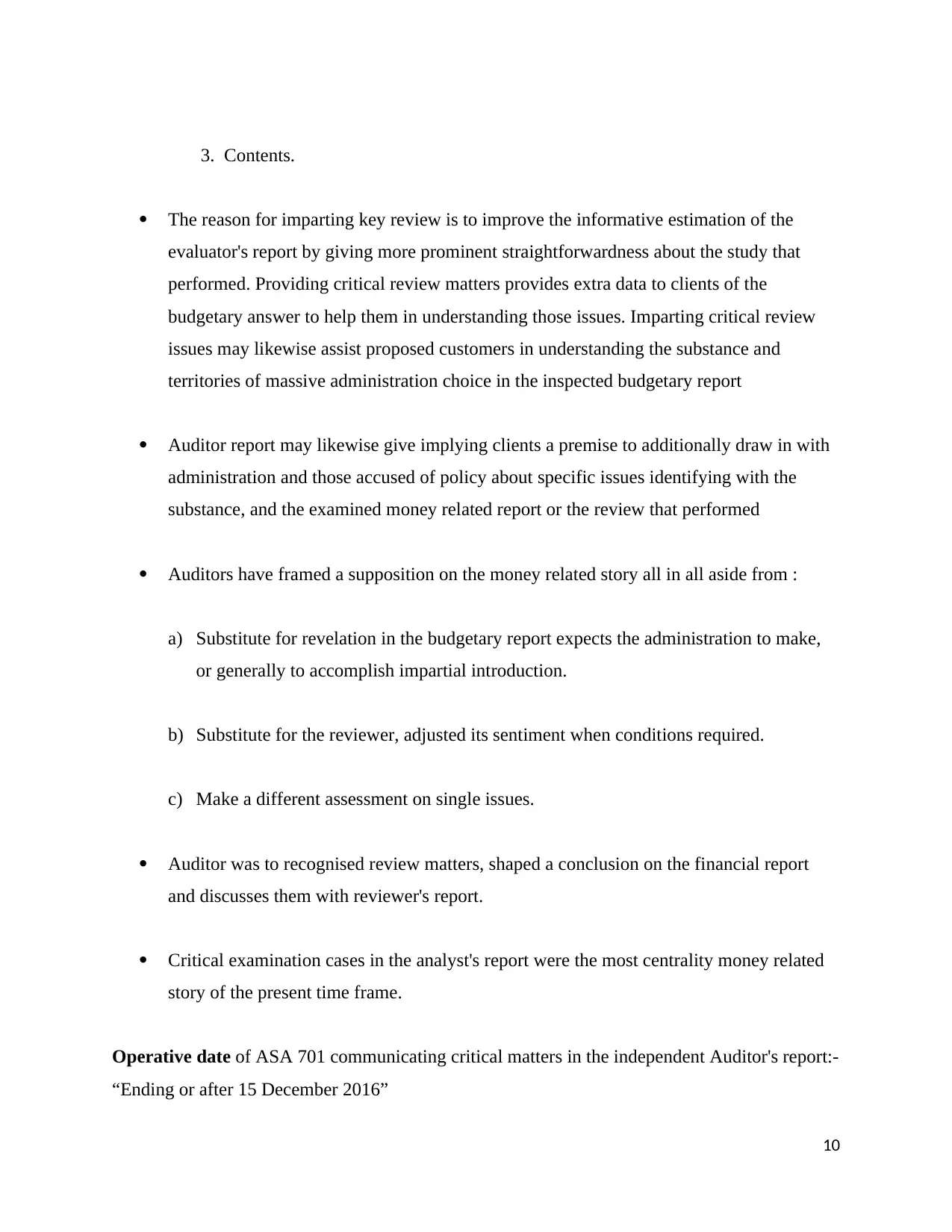
3. Contents.
The reason for imparting key review is to improve the informative estimation of the
evaluator's report by giving more prominent straightforwardness about the study that
performed. Providing critical review matters provides extra data to clients of the
budgetary answer to help them in understanding those issues. Imparting critical review
issues may likewise assist proposed customers in understanding the substance and
territories of massive administration choice in the inspected budgetary report
Auditor report may likewise give implying clients a premise to additionally draw in with
administration and those accused of policy about specific issues identifying with the
substance, and the examined money related report or the review that performed
Auditors have framed a supposition on the money related story all in all aside from :
a) Substitute for revelation in the budgetary report expects the administration to make,
or generally to accomplish impartial introduction.
b) Substitute for the reviewer, adjusted its sentiment when conditions required.
c) Make a different assessment on single issues.
Auditor was to recognised review matters, shaped a conclusion on the financial report
and discusses them with reviewer's report.
Critical examination cases in the analyst's report were the most centrality money related
story of the present time frame.
Operative date of ASA 701 communicating critical matters in the independent Auditor's report:-
“Ending or after 15 December 2016”
10
The reason for imparting key review is to improve the informative estimation of the
evaluator's report by giving more prominent straightforwardness about the study that
performed. Providing critical review matters provides extra data to clients of the
budgetary answer to help them in understanding those issues. Imparting critical review
issues may likewise assist proposed customers in understanding the substance and
territories of massive administration choice in the inspected budgetary report
Auditor report may likewise give implying clients a premise to additionally draw in with
administration and those accused of policy about specific issues identifying with the
substance, and the examined money related report or the review that performed
Auditors have framed a supposition on the money related story all in all aside from :
a) Substitute for revelation in the budgetary report expects the administration to make,
or generally to accomplish impartial introduction.
b) Substitute for the reviewer, adjusted its sentiment when conditions required.
c) Make a different assessment on single issues.
Auditor was to recognised review matters, shaped a conclusion on the financial report
and discusses them with reviewer's report.
Critical examination cases in the analyst's report were the most centrality money related
story of the present time frame.
Operative date of ASA 701 communicating critical matters in the independent Auditor's report:-
“Ending or after 15 December 2016”
10
Paraphrase This Document
Need a fresh take? Get an instant paraphrase of this document with our AI Paraphraser
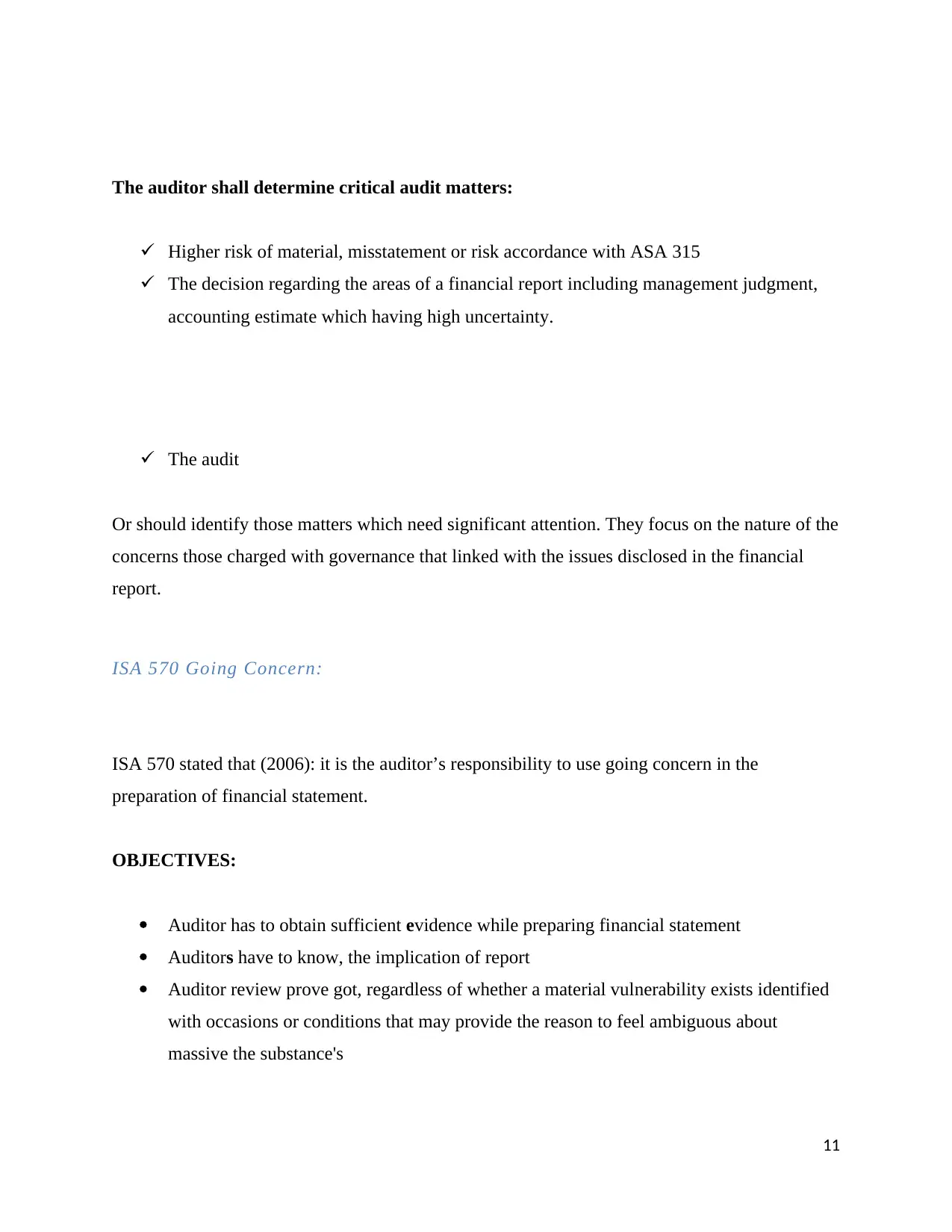
The auditor shall determine critical audit matters:
Higher risk of material, misstatement or risk accordance with ASA 315
The decision regarding the areas of a financial report including management judgment,
accounting estimate which having high uncertainty.
The audit
Or should identify those matters which need significant attention. They focus on the nature of the
concerns those charged with governance that linked with the issues disclosed in the financial
report.
ISA 570 Going Concern:
ISA 570 stated that (2006): it is the auditor’s responsibility to use going concern in the
preparation of financial statement.
OBJECTIVES:
Auditor has to obtain sufficient evidence while preparing financial statement
Auditors have to know, the implication of report
Auditor review prove got, regardless of whether a material vulnerability exists identified
with occasions or conditions that may provide the reason to feel ambiguous about
massive the substance's
11
Higher risk of material, misstatement or risk accordance with ASA 315
The decision regarding the areas of a financial report including management judgment,
accounting estimate which having high uncertainty.
The audit
Or should identify those matters which need significant attention. They focus on the nature of the
concerns those charged with governance that linked with the issues disclosed in the financial
report.
ISA 570 Going Concern:
ISA 570 stated that (2006): it is the auditor’s responsibility to use going concern in the
preparation of financial statement.
OBJECTIVES:
Auditor has to obtain sufficient evidence while preparing financial statement
Auditors have to know, the implication of report
Auditor review prove got, regardless of whether a material vulnerability exists identified
with occasions or conditions that may provide the reason to feel ambiguous about
massive the substance's
11
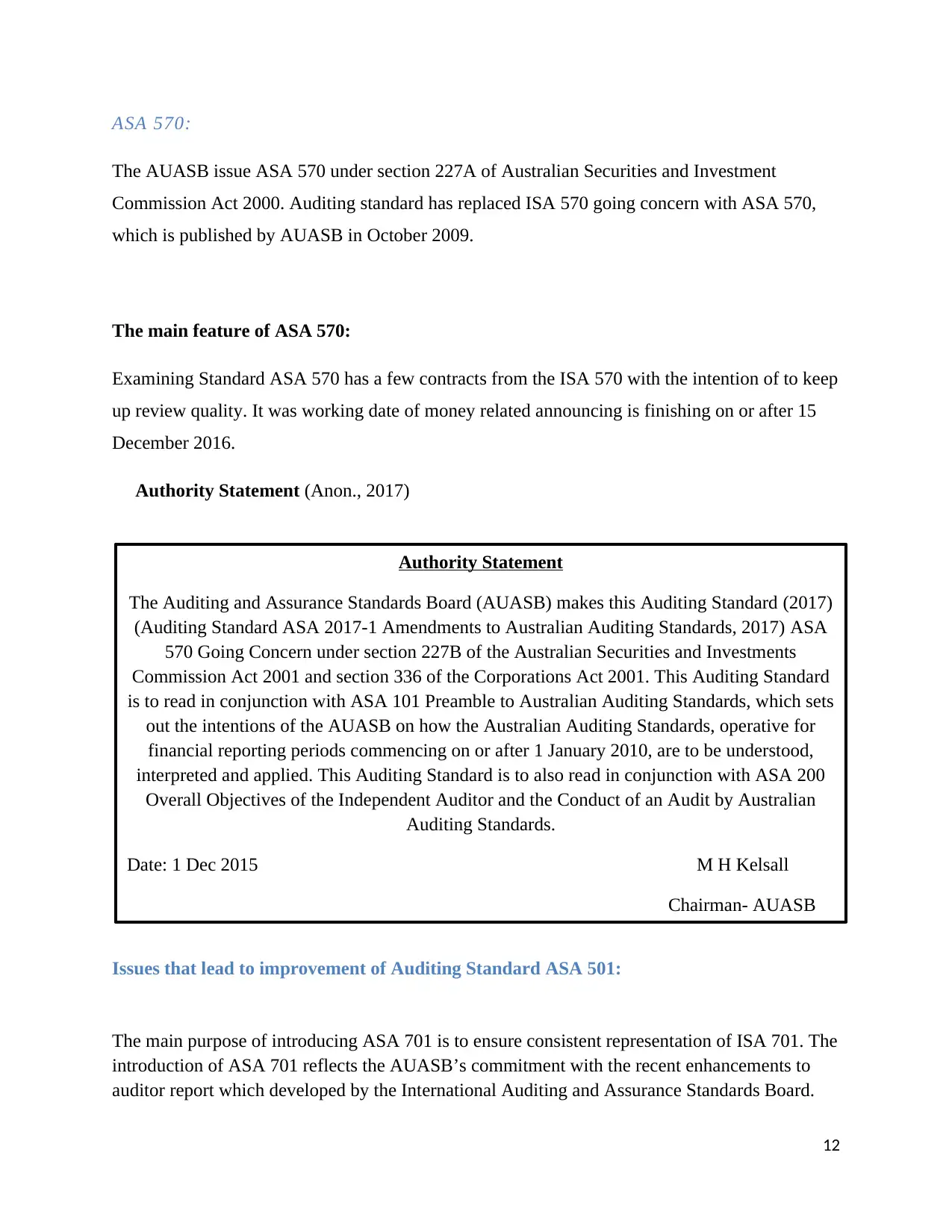
ASA 570:
The AUASB issue ASA 570 under section 227A of Australian Securities and Investment
Commission Act 2000. Auditing standard has replaced ISA 570 going concern with ASA 570,
which is published by AUASB in October 2009.
The main feature of ASA 570:
Examining Standard ASA 570 has a few contracts from the ISA 570 with the intention of to keep
up review quality. It was working date of money related announcing is finishing on or after 15
December 2016.
Authority Statement (Anon., 2017)
Issues that lead to improvement of Auditing Standard ASA 501:
The main purpose of introducing ASA 701 is to ensure consistent representation of ISA 701. The
introduction of ASA 701 reflects the AUASB’s commitment with the recent enhancements to
auditor report which developed by the International Auditing and Assurance Standards Board.
12
Authority Statement
The Auditing and Assurance Standards Board (AUASB) makes this Auditing Standard (2017)
(Auditing Standard ASA 2017-1 Amendments to Australian Auditing Standards, 2017) ASA
570 Going Concern under section 227B of the Australian Securities and Investments
Commission Act 2001 and section 336 of the Corporations Act 2001. This Auditing Standard
is to read in conjunction with ASA 101 Preamble to Australian Auditing Standards, which sets
out the intentions of the AUASB on how the Australian Auditing Standards, operative for
financial reporting periods commencing on or after 1 January 2010, are to be understood,
interpreted and applied. This Auditing Standard is to also read in conjunction with ASA 200
Overall Objectives of the Independent Auditor and the Conduct of an Audit by Australian
Auditing Standards.
Date: 1 Dec 2015 M H Kelsall
Chairman- AUASB
The AUASB issue ASA 570 under section 227A of Australian Securities and Investment
Commission Act 2000. Auditing standard has replaced ISA 570 going concern with ASA 570,
which is published by AUASB in October 2009.
The main feature of ASA 570:
Examining Standard ASA 570 has a few contracts from the ISA 570 with the intention of to keep
up review quality. It was working date of money related announcing is finishing on or after 15
December 2016.
Authority Statement (Anon., 2017)
Issues that lead to improvement of Auditing Standard ASA 501:
The main purpose of introducing ASA 701 is to ensure consistent representation of ISA 701. The
introduction of ASA 701 reflects the AUASB’s commitment with the recent enhancements to
auditor report which developed by the International Auditing and Assurance Standards Board.
12
Authority Statement
The Auditing and Assurance Standards Board (AUASB) makes this Auditing Standard (2017)
(Auditing Standard ASA 2017-1 Amendments to Australian Auditing Standards, 2017) ASA
570 Going Concern under section 227B of the Australian Securities and Investments
Commission Act 2001 and section 336 of the Corporations Act 2001. This Auditing Standard
is to read in conjunction with ASA 101 Preamble to Australian Auditing Standards, which sets
out the intentions of the AUASB on how the Australian Auditing Standards, operative for
financial reporting periods commencing on or after 1 January 2010, are to be understood,
interpreted and applied. This Auditing Standard is to also read in conjunction with ASA 200
Overall Objectives of the Independent Auditor and the Conduct of an Audit by Australian
Auditing Standards.
Date: 1 Dec 2015 M H Kelsall
Chairman- AUASB
⊘ This is a preview!⊘
Do you want full access?
Subscribe today to unlock all pages.

Trusted by 1+ million students worldwide
1 out of 16
Related Documents
Your All-in-One AI-Powered Toolkit for Academic Success.
+13062052269
info@desklib.com
Available 24*7 on WhatsApp / Email
![[object Object]](/_next/static/media/star-bottom.7253800d.svg)
Unlock your academic potential
Copyright © 2020–2025 A2Z Services. All Rights Reserved. Developed and managed by ZUCOL.





